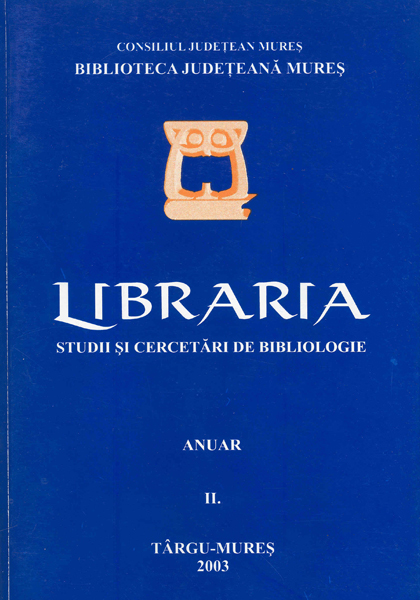Evoluţia tiparului românesc în Ţările Române în secolul al XVI-lea
The Evolution of Printing in Valahia, Transylvania and Moldavia During the 16th Century
old book
Author(s): Georgeta CHIRILĂSubject(s): Museology & Heritage Studies, Library and Information Science, Other
Published by: Biblioteca Județeană Mureș
Keywords: Libraria; Biblioteca Județeană Mureș; biblioteconomie; bibliologie; carte veche; carte bibliofilă; istorie locală; servicii de bibliotecă; Biblioteca Teleki; carte veche românească;
Summary/Abstract: Romanian historiography concerning this theme has now become veryrich, due to a large number of historians who analysed this issue.Thus, the present study tries to be an epitome of their outcomes. But it is also an effort to integrate the evolution of the Romanian printing activities inthe more general European phenomenon. The basic reasons for dwelling onthe theme in such a manner is very obvious if we consider the fact that theRomanian printing developed – in comparison to the European one –relatively fast: only 53 years after the first edited book; at 25 years after theprinting of the first Slavonic book and only 17 years after the printing of thefirst book in Cyrillic alphabet.Considering this, we analysed the activity of the Romanian editors whoworked during the 16th century. We started with Macarie, who worked inTârgovişte; then Filip Moldoveanul, considered to be the first editor whoprinted books in Romanian; then Dimitrie Liubavici; Coresi and hisapprentices and finally Lavrentie, who edited his books in Bucureşti (PlumbuitaMonastery).Taking into account all their achievements, these are some of the presentstudy’ s conclusions: 1) the printing of the first Romanian book is part of theEuropean phenomenon, a local reflection of it and neither an isolated nor analleatory evolution; 2) the beginnings are localised in Valahia, more precisely inTârgovişte, where Macarie printed in only 4 years (1508-1512) 3 religiousbooks; 3) the first Romanian book was printed in Transylvania: it was FilipMoldoveanul’ s Catehismul românesc. His example was followed by Coresiand his apprentices; 4) during the 16th century a large number of books wereedited both in Valahia and Transylvania; the printing activities can, and mustbe seen, as promotors of the cultural relations between Valahia, Transylvaniaand Moldavia. The latter, despite the fact that there were no editors and nobook was printed there during the 16th century, proved to be a very responsivespace for the books edited in Valahia and Transylvania; 6) all the books printedduring the 16th century were religious ones, thus we could say that the publictarget were the Romanian orthodox priests; they were, in fact, intermediaresbetween the common people and the „printed” word; we must take intoconsideration the influence that Religious Reform had upon the Romanianeditors and their work.As a general conclusion of the study, we remarked the great value of theRomanian printing activity, its impact upon the whole Romanian culture.
Journal: Libraria. Studii și cercetări de bibliologie
- Issue Year: II/2003
- Issue No: 2
- Page Range: 185-197
- Page Count: 13
- Language: Romanian

